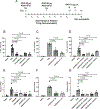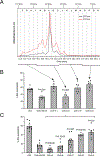Asthma-protective agents in dust from traditional farm environments
- PMID: 37271318
- PMCID: PMC10680491
- DOI: 10.1016/j.jaci.2023.05.013
Asthma-protective agents in dust from traditional farm environments
Abstract
Background: Growing up on traditional European or US Amish dairy farms in close contact with cows and hay protects children against asthma, and airway administration of extracts from dust collected from cowsheds of those farms prevents allergic asthma in mice.
Objectives: This study sought to begin identifying farm-derived asthma-protective agents.
Methods: Our work unfolded along 2 unbiased and independent but complementary discovery paths. Dust extracts (DEs) from protective and nonprotective farms (European and Amish cowsheds vs European sheep sheds) were analyzed by comparative nuclear magnetic resonance profiling and differential proteomics. Bioactivity-guided size fractionation focused on protective Amish cowshed DEs. Multiple in vitro and in vivo functional assays were used in both paths. Some of the proteins thus identified were characterized by in-solution and in-gel sodium dodecyl sulfate-polyacrylamide gel electrophoresis enzymatic digestion/peptide mapping followed by liquid chromatography/mass spectrometry. The cargo carried by these proteins was analyzed by untargeted liquid chromatography-high-resolution mass spectrometry.
Results: Twelve carrier proteins of animal and plant origin, including the bovine lipocalins Bos d 2 and odorant binding protein, were enriched in DEs from protective European cowsheds. A potent asthma-protective fraction of Amish cowshed DEs (≈0.5% of the total carbon content of unfractionated extracts) contained 7 animal and plant proteins, including Bos d 2 and odorant binding protein loaded with fatty acid metabolites from plants, bacteria, and fungi.
Conclusions: Animals and plants from traditional farms produce proteins that transport hydrophobic microbial and plant metabolites. When delivered to mucosal surfaces, these agents might regulate airway responses.
Keywords: Asthma; asthma protection; farm effect; microbial metabolites.
Copyright © 2023 The Authors. Published by Elsevier Inc. All rights reserved.
Conflict of interest statement
All the other authors declare no conflict of interest.
Figures





References
-
- WHO. Bronchial asthma Fact sheet N° 206. 2015.
-
- von Mutius E, Vercelli D. Farm living: effects on childhood asthma and allergy. Nat Rev Immunol 2010; 10:861–8. - PubMed
Publication types
MeSH terms
Substances
Grants and funding
LinkOut - more resources
Full Text Sources
Medical

